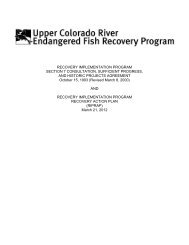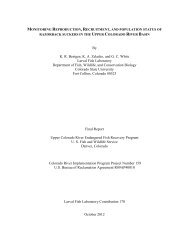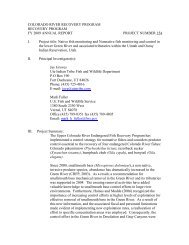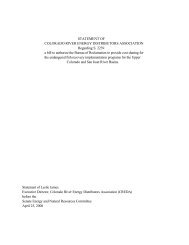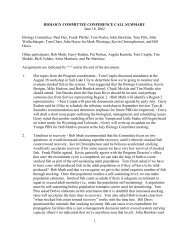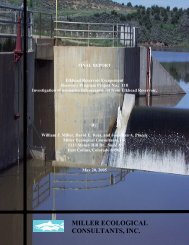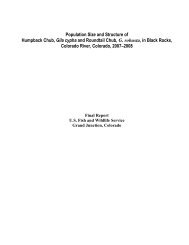odies. Signing <strong>of</strong> the Recovery Agreement will indicate support <strong>for</strong> the implementation <strong>of</strong>recovery actions identified in this opinion, and will provide immediate coverage to those waterusers <strong>for</strong> incidental take. If water users choose not to sign a recovery agreement, they could notrely on the Recovery Program <strong>for</strong> Endangered Species Act compliance. Reasonable and prudentalternatives outside the Recovery Program would have to be developed.Monetary charges <strong>for</strong> projects to fund Recovery Actions which choose to rely on the RecoveryProgram will be assessed consistent with documents establishing the Recovery Program (USFWS1987). Existing and future Reclamation projects remain exempt from the charge because theycontribute annually to the Recovery Program. All other new project proponents undergoingindividual section 7 consultations <strong>for</strong> depletions greater than 100 acre-feet/year are to pay the 1-time charge. New projects pay 10 percent at the time Federal funds or authorizations areobtained and the remainder prior to depletions occurring. Existing projects are to pay the charge<strong>for</strong> new depletions which have occurred since January 22, 1988. As additional new depletionsoccur from existing facilities that will have undergone section 7 in accordance with this biologicalopinion, a depletion charge will be assessed and paid prior to the actual depletion.The Service will continue to work with proponents <strong>of</strong> new water projects to minimize projectimpacts and look <strong>for</strong> mutually agreeable opportunities to provide conditions that benefit theendangered fishes. The Service intends to coordinate with the lead Federal Agency during theNational Environmental Policy Act process and conduct in<strong>for</strong>mal section 7 consultation, asappropriate. This will reduce the likelihood <strong>of</strong> reinitiation <strong>of</strong> consultation on existing and othernew projects that precede the subject project.STATUS OF THE SPECIES AND CRITICAL HABITATColorado PikeminnowSpecies/Critical Habitat DescriptionThe Colorado pikeminnow is the largest cyprinid fish (minnow family) native to North Americaand it evolved as the main predator in the Colorado River system. It is an elongated pike-like fishthat during predevelopment times, may have grown as large as 6 feet in length and weighed nearly100 pounds (Behnke and Benson 1983). Today, fish rarely exceed 3 feet in length or weigh morethan 18 pounds; such fish are estimated to be 45-55 years old (Osmundson et al. 1997). Themouth <strong>of</strong> this species is large and nearly horizontal with long slender pharyngeal teeth (located inthe throat), adapted <strong>for</strong> grasping and holding prey. The diet <strong>of</strong> Colorado pikeminnow longer than3 or 4 inches consists almost entirely <strong>of</strong> other fishes (Vanicek and Kramer 1969). Males becomesexually mature earlier and at a smaller size than do females, though all are mature by about age 7and 500 mm (20 inches) in length (Vanicek and Kramer 1969, Seethaler 1978, Hamman 1981).Adults are strongly countershaded with a dark, olive back, and a white belly. Young are silveryand usually have a dark, wedge-shaped spot at the base <strong>of</strong> the caudal fin.19
Based on early fish collection records, archaeological finds, and other observations, the Coloradopikeminnow was once found throughout warmwater reaches <strong>of</strong> the entire Colorado River Basindown to the Gulf <strong>of</strong> Cali<strong>for</strong>nia, and including reaches <strong>of</strong> the upper Colorado River and its majortributaries, the Green River and its major tributaries, and the Gila River system in Arizona(Seethaler 1978). Colorado pikeminnow apparently were never found in colder, headwater areas.Seethaler (1978) indicates that the species was abundant in suitable habitat throughout the entireColorado River Basin prior to the 1850's. No historic records exist that would indicate how farupstream Colorado pikeminnow once occurred in the Colorado River. The only reliable account<strong>of</strong> the species occurring upstream <strong>of</strong> the Price Stubb Dam near Palisade, Colorado, is from aService biologist who reports having captured Colorado pikeminnow 2-3 miles up Plateau Creekwhile angling there around 1960 (Bob Burdick pers. com.).Critical habitat was designated in 1994 within the 100-year floodplain <strong>of</strong> the Coloradopikeminnow's historical range in the following area <strong>of</strong> the upper Colorado River (59 F.R. 13374).Colorado, Mesa and Garfield Counties; and Utah, Grand, San Juan, Wayne, and GarfieldCounties. The Colorado River and its 100-year floodplain from the Colorado River Bridge at exit90 north <strong>of</strong>f Interstate 70 in T. 6 S., R. 93 W., section 16 (6th Principal Meridian) to North Wash,including the Dirty Devil arm <strong>of</strong> Lake Powell up to the full pool elevation, in T. 33 S., R. 14 E.,section 29 (Salt Lake Meridian).The Service has identified water, physical habitat, and the biological environment as the primaryconstituent elements <strong>of</strong> critical habitat. This includes a quantity <strong>of</strong> water <strong>of</strong> sufficient quality thatis delivered to a specific location in accordance with a hydrologic regime that is required <strong>for</strong> theparticular life stage <strong>for</strong> each species. The physical habitat includes areas <strong>of</strong> the Colorado Riversystem that are inhabited or potentially habitable <strong>for</strong> use in spawning and feeding, as a nursery, orserve as corridors between these areas. In addition, oxbows, backwaters, and other areas in the100-year floodplain, when inundated, provide access to spawning, nursery, feeding, and rearinghabitats. Food supply, predation, and competition are important elements <strong>of</strong> the biologicalenvironment.Status and DistributionColorado pikeminnow were historically distributed throughout warmwater reaches <strong>of</strong> theColorado River Basin from Wyoming and Colorado south to the Gulf <strong>of</strong> Cali<strong>for</strong>nia. By the1970's they were extirpated from the entire lower basin (downstream <strong>of</strong> Glen Canyon Dam) andfrom portions <strong>of</strong> the upper basin as a result <strong>of</strong> major alterations to the riverine environment.Having lost some 75-80 percent <strong>of</strong> its <strong>for</strong>mer range, the Colorado pikeminnow was federallylisted as an endangered species in 1967 (Miller 1961, Moyle 1976, Tyus 1991, Osmundson andBurnham 1998).Colorado pikeminnow are presently restricted to the Upper Colorado River Basin and inhabitwarmwater reaches <strong>of</strong> the Colorado, Green, and San Juan Rivers and associated tributaries. The20
- Page 1 and 2: FINAL PROGRAMMATIC BIOLOGICAL OPINI
- Page 3 and 4: INCIDENTAL TAKE ...................
- Page 5 and 6: 2" Reclamation’s portion of 120,0
- Page 7 and 8: On January 21-22, 1988, the Secreta
- Page 9 and 10: funding component of the Recovery P
- Page 11 and 12: 81. Habitat Protection ElementGener
- Page 13 and 14: Also, the Service and the Colorado
- Page 15 and 16: Table 1. The estimated benefits in
- Page 17 and 18: through recovery efforts that will
- Page 19 and 20: native fishes. Also, some species o
- Page 21: “new” depletions. This would in
- Page 25 and 26: infrequent pulsed recruitment make
- Page 27 and 28: Area, in the Loma to Black Rocks re
- Page 29 and 30: 26Figure 1. Distribution of adult C
- Page 31 and 32: during high flows. Some of the pike
- Page 33 and 34: In the Upper Basin, above Glen Cany
- Page 35 and 36: 32Populations DynamicsThere are no
- Page 37 and 38: in low velocity shorelines and back
- Page 39 and 40: 36IMPORTANCE OF THE 15-MILE REACHTh
- Page 41 and 42: occur in the 15-Mile Reach). Provid
- Page 43 and 44: Applying the above regulations, the
- Page 45 and 46: in a river basin. While the model i
- Page 47 and 48: 44Factors Affecting Species Environ
- Page 49 and 50: 46To determine conditions with wate
- Page 51 and 52: 48140001200010000CFS800060004000200
- Page 53 and 54: 50CFS240002200020000180001600014000
- Page 55 and 56: 52CFS280002600024000220002000018000
- Page 57 and 58: Release and protection of surplus H
- Page 59 and 60: 56CFS500045004000350030002500200015
- Page 61 and 62: The formation of a variety of chann
- Page 63 and 64: options will be determined through
- Page 65 and 66: Passage at the Price-Stubb Diversio
- Page 67 and 68: species. Recent population estimate
- Page 69 and 70: the endangered fishes. Ongoing Reco
- Page 71 and 72: 68the Colorado pikeminnow, razorbac
- Page 73 and 74:
70There are no current population e
- Page 75 and 76:
additional reasonable and prudent m
- Page 77 and 78:
The Recovery Action Plan is an adap
- Page 79 and 80:
76actions have all been completed a
- Page 81 and 82:
78LITERATURE CITEDAbbott, C. C. 186
- Page 83 and 84:
80the Upper Colorado River Basin, P
- Page 85 and 86:
Kaeding, L. R., and D. B. Osmundson
- Page 87 and 88:
Minckley, W. L. 1983. Status of the
- Page 89 and 90:
Pitlick, J., and M. Van Steeter. 19
- Page 91 and 92:
Tyus, H. M., B. D. Burdick, R. A. V
- Page 93:
Wick, E. J. 1997. Physical processe



